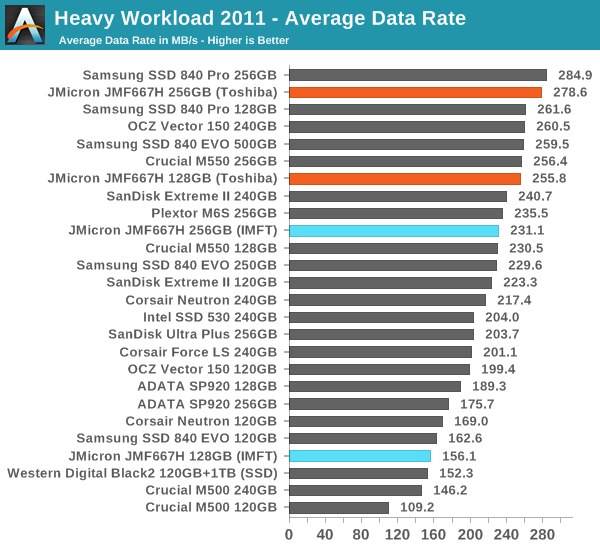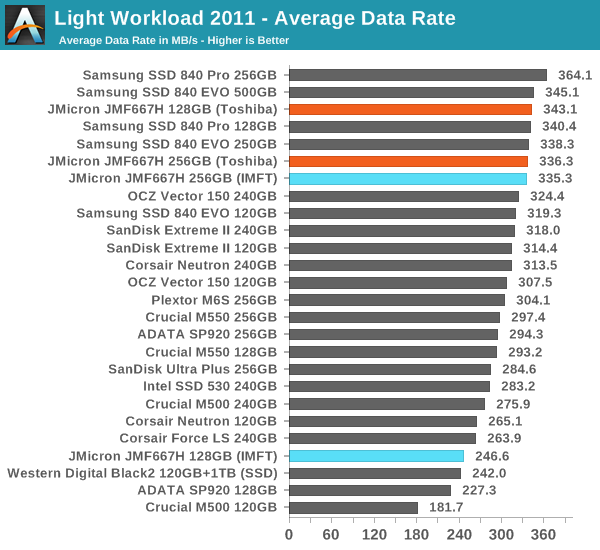JMicron JMF667H Reference Design (128GB & 256GB) Review
by Kristian Vättö on May 29, 2014 9:00 AM ESTAnandTech Storage Bench 2011
Back in 2011 (which seems like so long ago now!), we introduced our AnandTech Storage Bench, a suite of benchmarks that took traces of real OS/application usage and played them back in a repeatable manner. The MOASB, officially called AnandTech Storage Bench 2011 - Heavy Workload, mainly focuses on peak IO performance and basic garbage collection routines. There is a lot of downloading and application installing that happens during the course of this test. Our thinking was that it's during application installs, file copies, downloading and multitasking with all of this that you can really notice performance differences between drives. The full description of the Heavy test can be found here, while the Light workload details are here.

Wow, this is something I didn't expect. With Toshiba NAND, the JMF667H can in fact challenge Samsung's 840 Pro and beats several other SSDs. With IMFT NAND the performance is a bit worse but it's still average and about similar to what Samsung's 840 EVO offers.











28 Comments
View All Comments
mflood - Thursday, May 29, 2014 - link
Looks like a great product for last year. This might help JMicron capture some of the OEM market - maybe even some budget enthusiast SSDs. What JMicron didn't do was swoop in with a M2 x4 PCIExpress controller. I'm done with 6Gbps SATA.romrunning - Thursday, May 29, 2014 - link
Ahhhh.... JMicron - like a phoenix from the ashes. Fool me once, shame on you. Fool me twice...Oh well, someone has to be at the bottom of the barrel.
romrunning - Thursday, May 29, 2014 - link
I guess their selling point would be that they're cheaper than the Crucial M500. So if pricing is all-important to you (and why are you buying a SSD if price is all-important), then they would be a contender.The_Assimilator - Thursday, May 29, 2014 - link
Please stop insulting barrels.moridinga - Thursday, May 29, 2014 - link
"The JMF667H is not perfect and there are a couple of things I would like to see. The first one is support for TCG Opal 2.0 and IEEE-1667 encryption standards."IEEE-1667 is not an encryption standard. Perhaps you meant IEEE-1619
Kristian Vättö - Thursday, May 29, 2014 - link
Nope. IEEE-1667 is for storage devices, at least the version I'm looking at.http://www.ieee1667.com/download/informational-doc...
moridinga - Friday, May 30, 2014 - link
Yes, it is authentication and discovery for storage devices (particularly removable/portable ones). It says nothing about encryption.Gigaplex - Saturday, May 31, 2014 - link
IEEE-1667 is a requirement for Microsofts Bitlocker eDrive, which is encryption.KAlmquist - Thursday, May 29, 2014 - link
Contrary to the history given in the introduction, it was with the the Indilinx "barefoot" controller that was the game changer. Once Indrilinx entered the market, SSD's based on the J-Micron controller could only be sold to consumers who didn't understand what they were buying. The name J-Micron became toxic because if you wanted to advise somebody on buying an SSD, your first and last words would be, "whatever you do, don't buy and SSD with a J-Micron controller."In contrast, Sandforce's first generation controller was an incremental improvement over what came before it. There's nothing wrong with that, but the term "game changer" doesn't apply.
HisDivineOrder - Thursday, May 29, 2014 - link
Seems like that early history explanation really misses the point that Indilinx was the first real competition to Intel back then.Sandforce came along and was the first company to put Intel down. But Indilinx was the first company that convinced people they could live with non-Intel SSD's and not... be JMicron'ed.